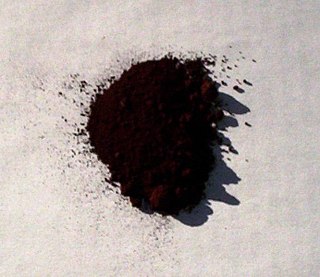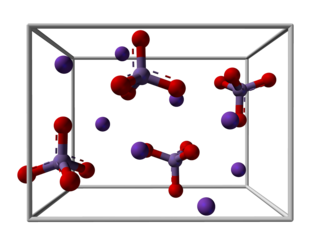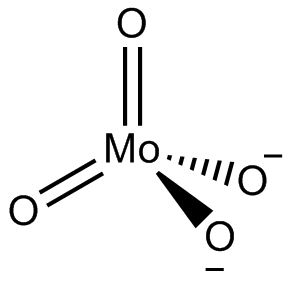Related Research Articles
In chemistry, titanate usually refers to inorganic compounds composed of titanium oxides, or oxides containing the titanium element. Together with niobate, titanate salts form the Perovskite group.

Chromate salts contain the chromate anion, CrO2−
4. Dichromate salts contain the dichromate anion, Cr
2O2−
7. They are oxyanions of chromium in the +6 oxidation state and are moderately strong oxidizing agents. In an aqueous solution, chromate and dichromate ions can be interconvertible.
In chemistry, perxenates are salts of the yellow xenon-containing anion XeO4−
6. This anion has octahedral molecular geometry, as determined by Raman spectroscopy, having O–Xe–O bond angles varying between 87° and 93°. The Xe–O bond length was determined by X-ray crystallography to be 1.875 Å.
In chemistry, the term stannate or tinnate refers to compounds of tin (Sn). Stannic acid (Sn(OH)4), the formal precursor to stannates, does not exist and is actually a hydrate of SnO2. The term is also used in naming conventions as a suffix; for example the hexachlorostannate ion is SnCl2−
6.

Lead(II,IV) oxide, also called red lead or minium, is the inorganic compound with the formula Pb3O4. A bright red or orange solid, it is used as pigment, in the manufacture of batteries, and rustproof primer paints. It is an example of a mixed valence compound, being composed of both Pb(II) and Pb(IV) in the ratio of two to one.

In inorganic nomenclature, a manganate is any negatively charged molecular entity with manganese as the central atom. However, the name is usually used to refer to the tetraoxidomanganate(2−) anion, MnO2−
4, also known as manganate(VI) because it contains manganese in the +6 oxidation state. Manganates are the only known manganese(VI) compounds.

Telluric acid, or more accurately orthotelluric acid, is a chemical compound with the formula Te(OH)6, often written as H6TeO6. It is a white crystalline solid made up of octahedral Te(OH)6 molecules which persist in aqueous solution. In the solid state, there are two forms, rhombohedral and monoclinic, and both contain octahedral Te(OH)6 molecules, containing one hexavalent tellurium (Te) atom in the +6 oxidation state, attached to six hydroxyl (–OH) groups, thus, it can be called tellurium(VI) hydroxide. Telluric acid is a weak acid which is dibasic, forming tellurate salts with strong bases and hydrogen tellurate salts with weaker bases or upon hydrolysis of tellurates in water. It is used as tellurium-source in the synthesis of oxidation catalysts.

Lead(IV) oxide, commonly known as lead dioxide, is an inorganic compound with the chemical formula PbO2. It is an oxide where lead is in an oxidation state of +4. It is a dark-brown solid which is insoluble in water. It exists in two crystalline forms. It has several important applications in electrochemistry, in particular as the positive plate of lead acid batteries.
In chemistry, plumbite is the PbO2−2 oxyanion or hydrated forms, or any salt containing this anion. In these salts, lead is in the oxidation state +2. It is the traditional term for the IUPAC name plumbate(II).

Potassium manganate is the inorganic compound with the formula K2MnO4. This green-colored salt is an intermediate in the industrial synthesis of potassium permanganate, a common chemical. Occasionally, potassium manganate and potassium permanganate are confused, but each compound's properties are distinct.
Selenium trioxide is the inorganic compound with the formula SeO3. It is white, hygroscopic solid. It is also an oxidizing agent and a Lewis acid. It is of academic interest as a precursor to Se(VI) compounds.

Barium ferrate is the chemical compound of formula BaFeO4. This is a rare compound containing iron in the +6 oxidation state. The ferrate(VI) ion has two unpaired electrons, making it paramagnetic. It is isostructural with BaSO4, and contains the tetrahedral [FeO4]2− anion.

In chemistry, germanate is a compound containing an oxyanion of germanium. In the naming of inorganic compounds it is a suffix that indicates a polyatomic anion with a central germanium atom, for example potassium hexafluorogermanate, K2GeF6.

In chemistry, a molybdate is a compound containing an oxyanion with molybdenum in its highest oxidation state of 6: O−−Mo(=O)2−O−. Molybdenum can form a very large range of such oxyanions, which can be discrete structures or polymeric extended structures, although the latter are only found in the solid state. The larger oxyanions are members of group of compounds termed polyoxometalates, and because they contain only one type of metal atom are often called isopolymetalates. The discrete molybdenum oxyanions range in size from the simplest MoO2−
4, found in potassium molybdate up to extremely large structures found in isopoly-molybdenum blues that contain for example 154 Mo atoms. The behaviour of molybdenum is different from the other elements in group 6. Chromium only forms the chromates, CrO2−
4, Cr
2O2−
7, Cr
3O2−
10 and Cr
4O2−
13 ions which are all based on tetrahedral chromium. Tungsten is similar to molybdenum and forms many tungstates containing 6 coordinate tungsten.

Compounds of lead exist with lead in two main oxidation states: +2 and +4. The former is more common. Inorganic lead(IV) compounds are typically strong oxidants or exist only in highly acidic solutions.

Polonium dioxide (also known as polonium(IV) oxide) is a chemical compound with the formula PoO2. It is one of three oxides of polonium, the other two being polonium monoxide (PoO) and polonium trioxide (PoO3). It is a pale yellow crystalline solid at room temperature. Under lowered pressure (such as a vacuum), it decomposes into elemental polonium and oxygen at 500 °C. It is the most stable oxide of polonium and is an interchalcogen.
The borotellurates are heteropoly anion compounds which have tellurate groups attached to boron atoms. The ratio of tellurate to borate reflects the degree of condensation. In [TeO4(BO3)2]8- the anions are linked into a chain. In [TeO2(BO3)4]10− the structure is zero dimensional with isolated anions. These arrangements of oxygen around boron and tellurium can have forms resembling silicates. The first borotellurates to be discovered were the mixed sodium rare earth compounds in 2015.
A selenate selenite is a chemical compound or salt that contains selenite and selenate anions (SeO32- and SeO42-). These are mixed anion compounds. Some have third anions.
References
- ↑ Krautscheid, Harald; Lode, Christine; Vielsack, Frieder; Vollmer, Heike (2001). "Synthesis and Crystal Structures of Iodoplumbate Chains, Ribbons and Rods with New Structural Types". Journal of the Chemical Society, Dalton Transactions (7): 1099–1104. doi:10.1039/b009488i.
- ↑ Krautscheid, Harald; Vielsack, Frieder (1995). "[Pb18I44]8−–An Iodoplumbate with an Unusual Structure". Angewandte Chemie International Edition in English. 34 (18): 2035–2037. doi:10.1002/anie.199520351.
- ↑ Yusoff, Abd. Rashid bin Mohd; Nazeeruddin, Mohammad Khaja (2016). "Organohalide Lead Perovskites for Photovoltaic Applications". The Journal of Physical Chemistry Letters. 7 (5): 851–866. doi:10.1021/acs.jpclett.5b02893. PMID 26885884.
- 1 2 3 Egon Wiberg; Nils Wiberg; Arnold Frederick Holleman (2001). Inorganic chemistry. Academic Press. p. 920. ISBN 0-12-352651-5.
- ↑ Newell, Lyman C.; Maxson (1939). "Lead Dioxide". Inorganic Syntheses. 1: 45–47. doi:10.1002/9780470132326.ch16.
- ↑ Sleight, A.W.; Gillson, J.L.; Bierstedt, P.E. (1975). "High-Temperature Superconductivity in the BaPb1−xBixO3 Systems". Solid State Communications. 17 (1): 27–28. Bibcode:1975SSCom..17...27S. doi:10.1016/0038-1098(75)90327-0.